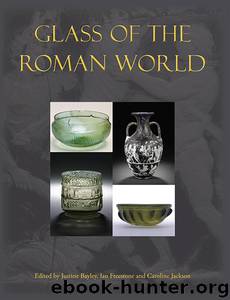Glass of the Roman World by Unknown

Author:Unknown
Language: eng
Format: epub
Tags: SOCIAL SCIENCE / Archaeology
ISBN: 9781782977759
Publisher: Casemate Publishers & Book Distributors, LLC
Published: 2015-07-30T16:00:00+00:00
Fig. 7.13: Fragment of translucent deep blue mould-blown cup (skyphos) preserving the lower left corner of a tabula ansata at the top right framing the glassblower’s signature. From a late Augustan context (before AD 14) at Magdalensberg, Austria. After Czurda-Ruth 1998, pl. 2, no. 782. Height of fragment 3.5cm. (By permission).
Inventions in Rome
Pliny’s remarks on the manufacturing techniques for which Sidon had been famous in the first quarter of the 1st century AD and earlier are complemented by Strabo’s remarks on technical improvements in the West: ‘At Rome, also, it is said that many inventions are made, both for producing the colours and for facilitating production techniques, as for example of wares resembling rock crystal; thus one can buy there a [glass] bowl or drinking vessel for a copper.’ (Strabo, Geography 16.2.25; translation by the author).
Strabo lived into his eighties. The improvements in Rome must have coincided with Sidon’s years of fame, since he died in 23/24 AD, the year in which Pliny was born. He wrote at least part of his Geography while he lived in Rome (Radt 2001, 1022), but although the phrasing of 16.2.25 implies the improvements were recent at the time of his writing, the text does not suggest he got his information in the city. Strabo concentrated his remarks on glassmaking in the chapter on the Syro-Palestinian coast. The improvements in Rome follow reports on primary glassmaking at Sidon and in Egypt where Strabo lived from about 25/24 BC perhaps until 20 BC and actually spoke with glassmakers in Alexandria.
Archaeological evidence suggests the new colouring techniques were invented in the early Augustan period. The colours were obtained by adding metal oxides. Certain colours appear to have been achieved with an unusual glass composition based on the addition of plant ashes (Thirion-Merle 2005, 42). The improved colouring techniques set off an entire industry of counterfeiting. Pliny (HN 37.199–200) explains at length how to distinguish counterfeits from precious stones.
Numerous glass vessels dating from the last quarter of the 1st century BC and the first half of the 1st century AD illustrate the wide range of brilliant colours achieved in Rome. The names modern scholars have given to early imperial glassware are revealing: strongly coloured monochrome glass, translucent and opaque fine wares, cameo-glass, colour-band glass, gold-band glass, reticella or network glass, and various classes of polychrome mosaic glass. All these wares were characteristic luxury products of workshops in Italy, many of which were probably located in Rome. The vivid colours are so characteristic that they have become an important criterion for proposing a western origin for similar vessels excavated occasionally in the East.
If the new colouring techniques in Rome have been associated correctly with the early Augustan period, they were invented at around the time when ‘glass pottery’ techniques are believed to have become known in Rome (see above). Combined with the improvement of eastern Mediterranean production techniques, the new recipes for colouring played a significant role in the success of the nascent (western) Roman glass industry. Mosaic
Download
This site does not store any files on its server. We only index and link to content provided by other sites. Please contact the content providers to delete copyright contents if any and email us, we'll remove relevant links or contents immediately.
The Secret History by Donna Tartt(16653)
Red Sparrow by Jason Matthews(4679)
Harry Potter 02 & The Chamber Of Secrets (Illustrated) by J.K. Rowling(3293)
In a Sunburned Country by Bill Bryson(2951)
Figure Drawing for Artists by Steve Huston(2803)
The Daily Stoic by Holiday Ryan & Hanselman Stephen(2712)
Drawing Cutting Edge Anatomy by Christopher Hart(2682)
The Roots of Romanticism (Second Edition) by Berlin Isaiah Hardy Henry Gray John(2569)
Japanese Design by Patricia J. Graham(2560)
Make Comics Like the Pros by Greg Pak(2427)
Stacked Decks by The Rotenberg Collection(2280)
Harry Potter and the Deathly Hallows (7) by J.K. Rowling(2218)
On Photography by Susan Sontag(2136)
Draw-A-Saurus by James Silvani(2108)
Tattoo Art by Doralba Picerno(2085)
Foreign Devils on the Silk Road: The Search for the Lost Treasures of Central Asia by Peter Hopkirk(2058)
Harry Potter and the Prisoner of Azkaban (Book 3) by J. K. Rowling(2028)
The Traveler's Gift by Andy Andrews(2016)
Churchill by Paul Johnson(2015)
